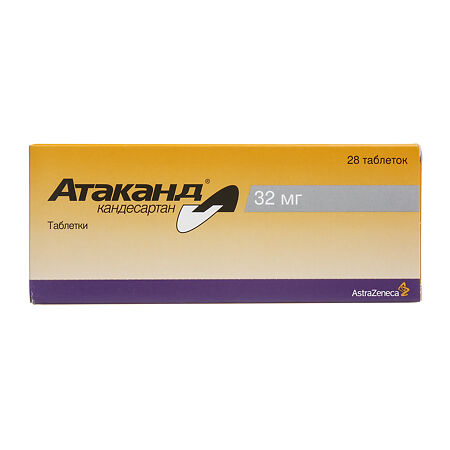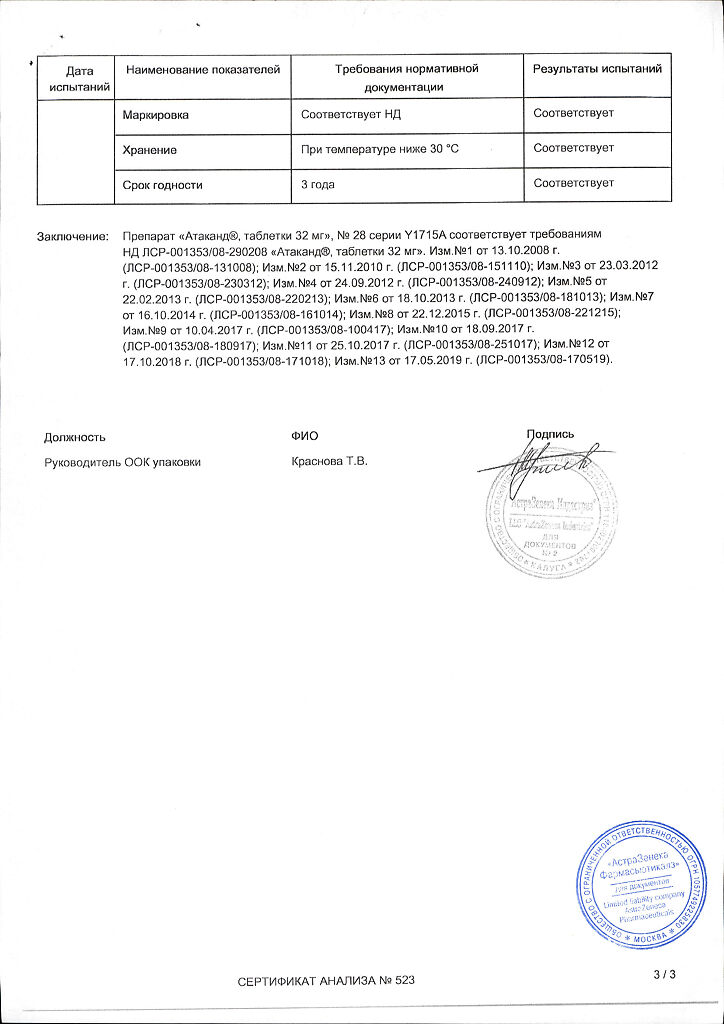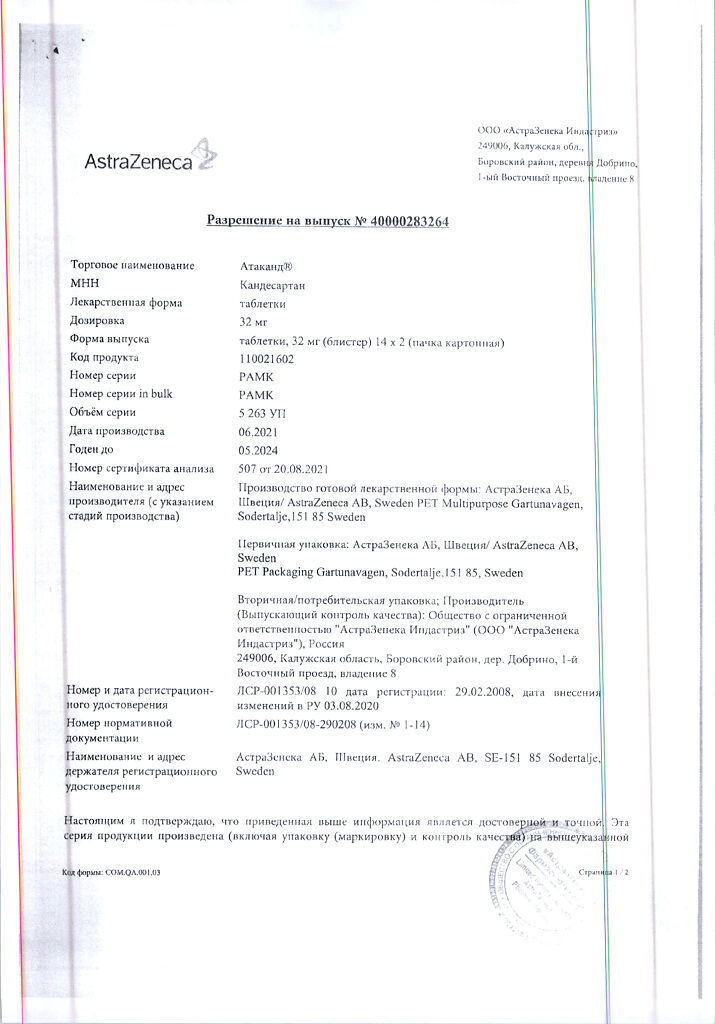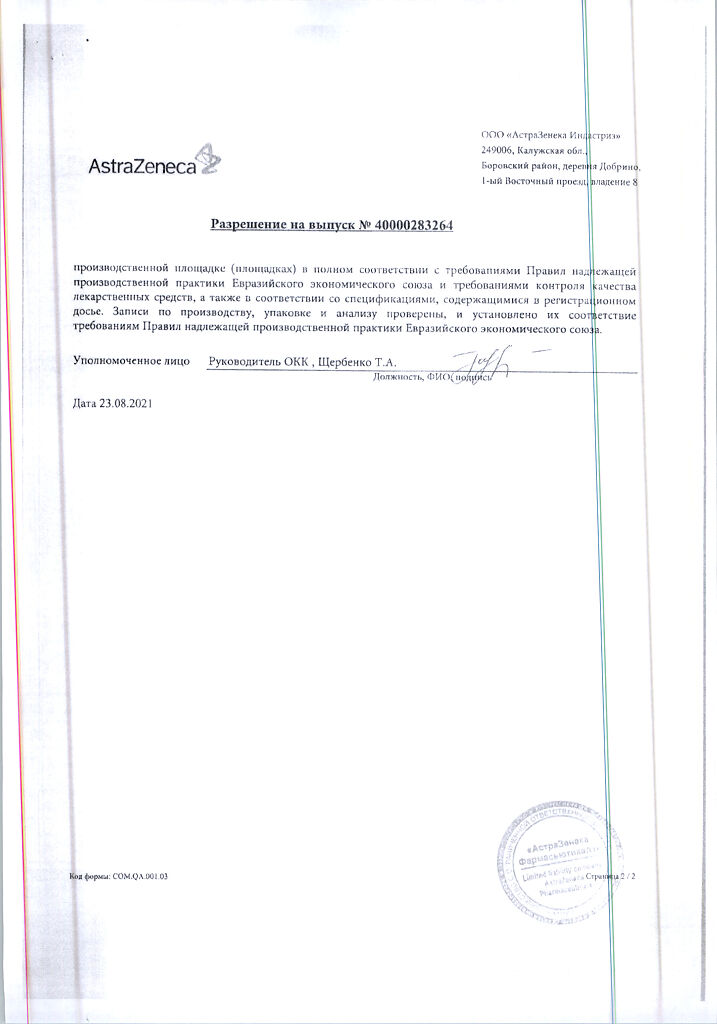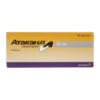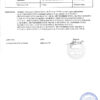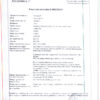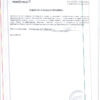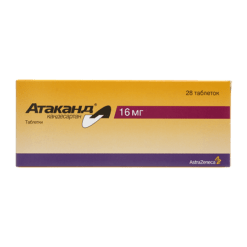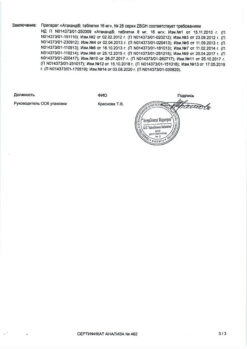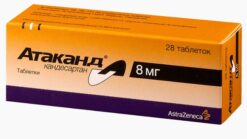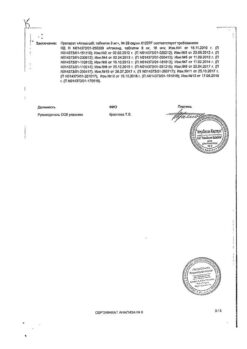No products in the cart.
Atakand, 32 mg tablets 28 pcs
€125.20 €104.33
Description
Atacand has a hypotensive effect.
It selectively blocks angiotensin II receptors (type AT1).
Indications
Indications
Arterial hypertension.
Pharmacological effect
Pharmacological effect
Atacand has a hypotensive effect.
Selectively blocks angiotensin II receptors (type AT1).
Special instructions
Special instructions
When prescribing Atacand to patients with renal artery stenosis (bilateral or single artery stenosis), it should be taken into account that drugs that affect the renin-angiotensin-aldosterone system (ACE inhibitors) may increase the concentration of urea and creatinine in the blood serum. There is a possibility (unconfirmed) that similar effects may be observed with the use of angiotensin II antagonists.
Patients receiving hydrochlorothiazide at a dose of 12.5 mg tolerated subsequent use of Atacand at a dose of 8 mg. Patients also tolerate simultaneous therapy with hydrochlorothiazide at a dose of up to 25 mg and Atacand at a dose of 8-16 mg for 8 weeks. However, with a pronounced decrease in blood volume (when diuretics are used in high doses), symptomatic hypotension may occur, which is also typical for other drugs that affect the renin-angiotensin-aldosterone system. Obviously, this condition must be corrected before using Atacand.
Concomitant use of Atacand with potassium-sparing diuretics that do not remove potassium from the body can theoretically lead to an increase in serum potassium concentrations. Caution should be exercised if this combination is necessary.
Use in pediatrics
The clinical effectiveness and safety of Atacand in children has not been established.
Active ingredient
Active ingredient
Candesartan
Composition
Composition
1 tablet contains candesartan cilexetil 32 mg.
Pregnancy
Pregnancy
The drug is contraindicated for use during pregnancy.
Experimental studies have found that the use of candesartan leads to impaired renal function in the fetus in late stages of development, as well as in the neonatal period. The mechanism of this action is probably related to the effect of the drug on the renin-angiotensin-aldosterone system.
In humans, fetal renal perfusion, which depends on the state of the renin-angiotensin-aldosterone system, begins in the second trimester of pregnancy. Thus, the risk to the fetus increases when taking the drug in the second trimester.
It has not been established whether candesartan is excreted in breast milk.
If it is necessary to use the drug during lactation, breastfeeding should be stopped due to the potential for the development of negative side effects in the child.
In experimental studies, candesartan was found in the milk of lactating rats.
Contraindications
Contraindications
Hypersensitivity; pregnancy, breastfeeding; childhood.
Side Effects
Side Effects
From the side of the central nervous system: often (more than 2%) – headache, dizziness.
From laboratory parameters: increased AST activity (slightly higher than in the groups taking placebo). In general, no clinically significant changes in laboratory parameters were detected when taking Atacand.
Other: often (more than 2%) – back pain.
Clinical trials revealed that the drug was well tolerated; the incidence of side effects was comparable to placebo and did not depend on the dose of the drug, as well as on the age and gender of the patient. In general, side effects were moderate and temporary. The number of cases of drug discontinuation due to side effects was similar to the number in the group of patients taking candesartan cilexetil and placebo.
The cause-and-effect relationship between taking Atacand and the described side effects has not been established.
Overdose
Overdose
Symptoms
Analysis of the pharmacological properties of the drug suggests that the main manifestation of an overdose may be a clinically significant decrease in blood pressure and dizziness. Isolated cases of drug overdose (up to 672 mg of candesartan cilexetil) have been described, resulting in the recovery of patients without serious consequences.
Treatment
With the development of clinically significant arterial hypotension, it is necessary to carry out symptomatic treatment and monitor the patient’s condition. Lay the patient down and raise the head of the bed. If necessary, the volume of circulating plasma should be increased, for example, by intravenous administration of an isotonic sodium chloride solution. If necessary, sympathomimetic drugs can be prescribed. Elimination of candesartan by hemodialysis is unlikely.
Storage conditions
Storage conditions
At a temperature not exceeding 30 °C
Shelf life
Shelf life
3 years
Manufacturer
Manufacturer
AstraZeneca AB, Sweden
Additional information
| Shelf life | 3 years |
|---|---|
| Conditions of storage | At a temperature not exceeding 30 °C |
| Manufacturer | AstraZeneca AB, Sweden |
| Medication form | pills |
| Brand | AstraZeneca AB |
Other forms…
Related products
Buy Atakand, 32 mg tablets 28 pcs with delivery to USA, UK, Europe and over 120 other countries.

